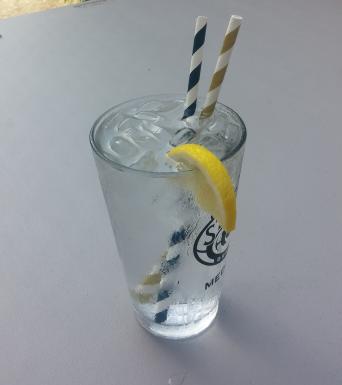
Editor's Note: The Last Straw
It seems like only a few months ago I was complaining about single-use plastic water bottles. (It was April.) Now everybody is all upset about plastic straws. Blame this — www.youtube.com/watch?v=4wH878t78bw, the viral video of the sea turtle having a bloody straw wrenched (or more precisely, multi-tooled) out of its nostril. Not that I or even the turtle folks are in the lead on this; the Weavers Way Environment Committee’s Marsha Low columnized about plastic-straw pollution last year, and it was easy to find a picture of plastic straws tangled in beach litter to illustrate it.
Although straws are possibly the oldest-known eating utensil (see Sumerian tombs circa 3,000 BCE), with a design based on an artifact from actual nature — that would be straw — the “modern” manufactured straw dates from the 1880s, and didn’t become plastic until the 1960s. (I Google so you don’t have to.)
Now with Seattle and Disney and Starbucks and I forget who all else getting rid of them, I asked Peggy Zwerver, one of the owners of Earth Bread + Brewery in Mt. Airy and Bar Hygge in Fairmount, about making the transition to a world without plastic straws.
And what do you know, it turns out sourcing sustainable straws is complicated. Paper straws cost 4-5 cents apiece compared to plastic at about a half-cent. And there’s such a demand for paper straws now that they’re hard to find. “Restaurant Depot doesn’t have them,” Peggy said. “I’ve gotten them online and I’ve gotten them in a different place every single time. Now there’s this company Aardvark — they’re inundated and they have a huge lead time but they’re awesome because once you order from them they put you on this map on their website.”
But bottom line, she’s just giving out fewer straws, which aligns with Earth’s sustainability message anyway: “When we serve soda, we don’t put a straw in. When we serve cocktails, we don’t put a straw in. If there’s a request for one, then we give it to them.” (Kids of a certain age automatically get a straw, and a lid, because, well, small motor skills.)
Peggy has also considered straws made of PLA (polylactic acid), the latest great sustainable hope. PLA is made from corn (well, once the corn is cracked into a polymer) and is theoretically compostable (which is yet another discussion). They act like plastic straws and they look like plastic straws — which is the problem, according to Weavers Way Tsar of All Compost Scott Blunk. “There’s no way to tell if they’re compostable unless they make all the PLA straws purple or something,” he said. “We can’t sort them out.”
“Paper straws you can see,” he added, “because they’re all collapsed to mush.” (I myself experienced a cozy sense of deju vu as I chomped down on a paper straw recently, though it was in a bar rather than the lunchroom in the sixth grade.)
Weavers Way Purchasing Manager Norman Weiss is amused. “I once took a plastic straw with me when I moved from Philly to San Francisco and brought it back with me four years later. I think I used it another two years and then it finally got brittle and started to crack lengthwise.
“I know the turtle video was horrible but I don’t understand why straws became the focus when people are double-bagging millions of times a day. Not to mention the water bottles. Yet straws get the wrath.”
Well, because straws are easy. No one without swallowing or mobility issues actually needs a straw. Who knows, maybe learning about the problem of plastic straws will entice a few more citizens to think about solid-waste disposal, or sustainability, or even other folks’ swallowing and mobility issues.
There I go, being a cockeyed optimist. As long as I don’t have to watch that turtle video again.

